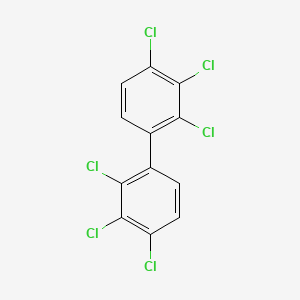D0783 | aroclor 1260
| Toxicity | Dose | Time | Species | Model | Method | Action | Positive criterion | Reference |
|---|---|---|---|---|---|---|---|---|
| MEMBRANE POTENTIAL | 21.47±2.75 | human | qHTS-HepG2 | MMP assay | decrease | IC50 | 163 | |
| MEMBRANE POTENTIAL | 12.59 | human | HepG2 | MMP assay | decrease | IC50 | 163 | |
| MEMBRANE POTENTIAL | rat | hepatocytes | MMP assay | Negative | IC50 | 163 | ||
| Pictogram | Signal | Statements | Precautionary Statement Codes |
|---|---|---|---|
  |
Warning |
Aggregated GHS information provided by 41 companies from 2 notifications to the ECHA C&L Inventory. Each notification may be associated with multiple companies. Reported as not meeting GHS hazard criteria by 3 of 41 companies. For more detailed information, please visit ECHA C&L website Of the 1 notification(s) provided by 38 of 41 companies with hazard statement code(s): H373 (100%): Causes damage to organs through prolonged or repeated exposure [Warning Specific target organ toxicity, repeated exposure] H400 (100%): Very toxic to aquatic life [Warning Hazardous to the aquatic environment, acute hazard] H410 (100%): Very toxic to aquatic life with long lasting effects [Warning Hazardous to the aquatic environment, long-term hazard] Information may vary between notifications depending on impurities, additives, and other factors. The percentage value in parenthesis indicates the notified classification ratio from companies that provide hazard codes. Only hazard codes with percentage values above 10% are shown. |
P260, P273, P314, P391, and P501; (The corresponding statement to each P-code can be found at the GHS Classification page.) |
| Organism | Test type | Route | Dose (normalized dose) | Effect | Source |
|---|---|---|---|---|---|
| rabbit | LDLo | skin | 2gm/kg (2000mg/kg) | Annual Review of Pharmacology. Vol. 14, Pg. 139, 1974. | |
| rat | LD50 | oral | 1315mg/kg (1315mg/kg) | Food and Cosmetics Toxicology. Vol. 12, Pg. 63, 1974. | |
| 1,1'-Biphenyl, 2,2',3,3',4,4'-hexachloro- | 1,1'-Biphenyl,2,2',3,3',4,4'-hexachloro- | 1,2,3-trichloro-4-(2,3,4-trichlorophenyl)benzene |
| 11096-82-5 | 2,2',3,3',4,4'-HEXACHLOROBIPHENYL | 2,2',3,3',4,4'-Hexachloro-1,1'-biphenyl |
| 2,2',3,3',4,4'-Hexachloro-1,1'-biphenyl # | 2,2'3,3',4,4'-Hexachloro-1,1'-biphenyl | 2,3,4,2',3',4'-Hexachlorobiphenyl |
| 38380-07-3 | AROCHLOR 1260 (9CI) (CHEMICALMIXTURE) | AROCLOR 1260 |
| Arochlor 1260 | Aroclor 1260 solution | BRN 2508232 |
| BTAGRXWGMYTPBY-UHFFFAOYSA-N | CAS-11096-82-5 | CCRIS 901 |
| CHEMBL3189099 | CTK4H9866 | Chlorodiphenyl (60% Cl) |
| Clophen A 60 | DSSTox_CID_101 | DSSTox_GSID_20101 |
| DSSTox_RID_75367 | DTXSID50858932 | HSDB 1822 |
| InChI=1/C12H4Cl6/c13-7-3-1-5(9(15)11(7)17)6-2-4-8(14)12(18)10(6)16/h1-4; | J-002495 | LS-2210 |
| LS-44408 | NCGC00248554-01 | NCGC00257737-01 |
| PCB 1260 | PCB 128 | PCB 128 (2,2',3,3',4,4'-Hexachlorobiphenyl) |
| PCB No. 128 | PCB No. 128 10 microg/mL in Isooctane | PCB-1260 |
| PCB-128 | PJ11O9J71Y | Phenoclor DP6 |
| Polychlorinated biphenyl (aroclor 1260) | Q26841006 | SCHEMBL308791 |
| Tox21_200183 | UNII-416O992G98 component BTAGRXWGMYTPBY-UHFFFAOYSA-N | UNII-PJ11O9J71Y |
| ZINC2521556 | polychlorinated biphenyl 1260 |
| CAS Number | 11096-82-5, 11096-99-4, 38380-07-3 |
| PubChem Compound | 38018 |

